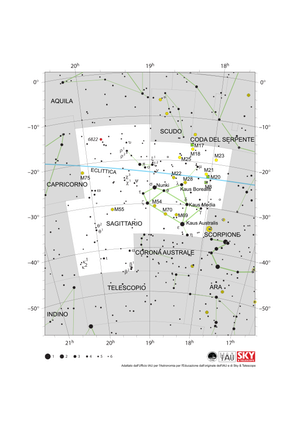Termine del Glossario Sagittario A*
Descrizione Le osservazioni dei moti delle stelle e del gas intorno al centro della Via Lattea forniscono prove indirette dell'esistenza di un buco nero super-massiccio, con una massa di circa 4,5 milioni di volte quella del Sole e un diametro di 40 milioni di chilometri, situato a circa 27.000 anni luce dalla Terra. Sagittario A* (Sagittario A-star) è la sorgente radio compatta associata al buco nero super-massiccio. È stata osservata in diverse lunghezze d'onda, soprattutto nella lunghezza d'onda delle onde radio. Il nome Sagittario deriva dal fatto che, osservata dalla Terra, si trova nella costellazione del Sagittario. La lettera A è dovuta al fatto che è la più luminosa e la prima sorgente radio extra-solare scoperta nella costellazione. C'è l'asterisco perché in fisica gli atomi in stati eccitati sono indicati da *, e Sgr A* è stata una scoperta entusiasmante.
Nel 2022, la Event Horizon Telescope Collaboration ha pubblicato la prima immagine in assoluto della silhouette ("ombra") del buco nero associato a Sgr A*.
Termini correlati
Vedi questo termine in altre lingue
status del termine e della definizione La definizione originale di questo termine in inglese é stata approvata da un ricercatore astronomo e da un docente La traduzione di questo termine e della sua definizione sono state approvate da un ricercatore astronomo e da un docente
Il Glossario Multilingue OAE é un progetto dell'Ufficio IAU per la didatticadell'astronomia (OAE) in collaborazione con l'ufficio IAU OAO per la DivulgazioneAstronomica (OAO). I termini e le definizioni sono stater scelte, scritte eriviste da un impegno collettivo da parte di OAE, i Centri e i Nodi OAE e iCoordinatori Nazionali per la Didattica dell'Astronomia e da altri volontari.Potete trovare una lista completa dei crediti, Tutti i termini del glossarioE le definizioni sono pubblicate su Creative Commons CC BY-4.0 licenza e dovrebbero essere accreditate ad IAU OAE.
Se noti un errore di fatto o di traduzione in questo termine del glossario, per favore contattaci.
Diagrami correlati
Mappa della costellazione del Sagittario
Crediti: Adattato dall'Ufficio IAU per l'Astronomia per l'Educazione dall'originale di IAU/Sky & Telescope
License: CC-BY-4.0 Creative Commons Attribuzione 4.0 Internazionale (CC BY 4.0) icone









